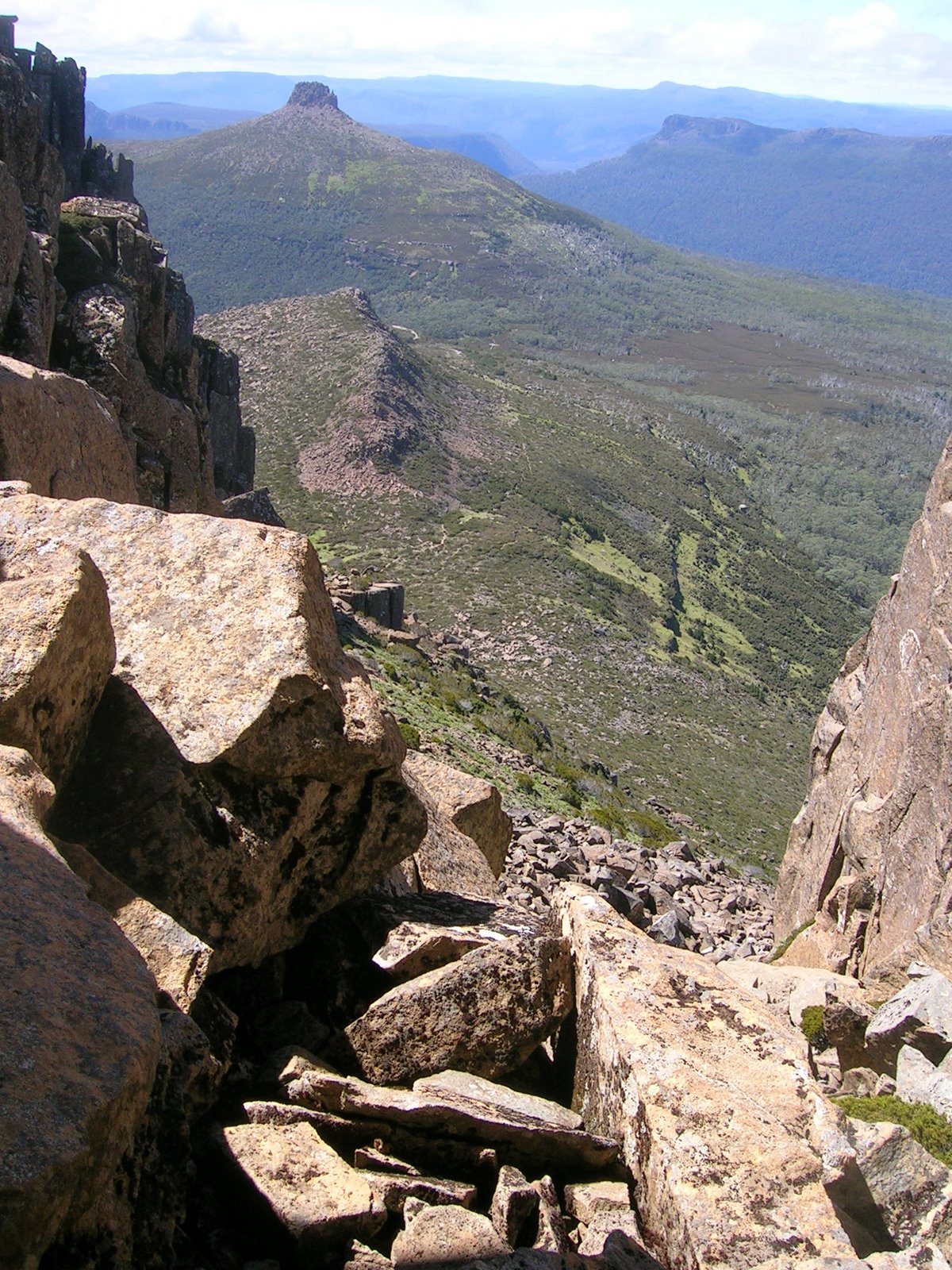|
Grattai Mountain
The Grattai Mountain, a mountain located within the Nandewar Range, is situated within the North West Slopes region of New South Wales, Australia. The mountain was formed by the Nandewar Volcano around 21 million years ago. The mountain has an elevation of above sea level and lies within the Mount Kaputar National Park The Mount Kaputar National Park is a national park located in New South Wales, Australia, surrounding the proximities of Mount Kaputar, a volcano active between 17 and 21 million years ago. It is located east of Narrabri and northwest of .... It is rarely climbed due to its isolation, lack of walking tracks and the cliffs which almost encircle the summit plateau. For those who do make it to the top, a visitors log is located in a metal box underneath a large rock. See also * List of mountains in New South Wales References Mountains of New South Wales North West Slopes {{NewSouthWales-geo-stub ... [...More Info...] [...Related Items...] OR: [Wikipedia] [Google] [Baidu] |
Nandewar Range
The Nandewar Range, a mountain range that is part of the Great Dividing Range, is located in the North West Slopes region of New South Wales, Australia. The range is situated approximately east of the township of Narrabri. John Oxley was the first European to see the range in 1818 as he explored the New South Wales. Location and features The range is located on the western, inland, side of the New England region, and generally forms the watershed divide between the Namoi River and Gwydir River catchment basins to the south and north respectively. The Macdonald River starting south of Walcha drains west to Warrabah National Park where it changes its name to the Namoi then is added to by the Manilla River, Peel River and Mooki River. The Horton River runs north to the Gwydir. Both rivers together drain segments of the Nandewar Range. The eastern part of the Nandewar Range starts at the Great Dividing Range south of Uralla. The main road between Barraba and Bingara crosses ... [...More Info...] [...Related Items...] OR: [Wikipedia] [Google] [Baidu] |
North West Slopes
The North West Slopes region of New South Wales, Australia, refers generally to the area west of the Northern Tablelands, to the north of the Central West region and to the east of the Far West region. Despite its name, the region is in north-central New South Wales, corresponding generally to the Australian Bureau of Meteorology's forecast area of ''North West Slopes and Plains''. The administrative areas of the region include the city of Tamworth, Gunnedah, Moree, Narrabri and Inverell. The region is higher, hillier and wetter on its eastern edge than on its western edge. The North West Slopes are situated on various tributaries to the Darling River, such as the Barwon, Gwydir, and Namoi Rivers, which rise in the Great Dividing Range country to its east. The region has one city, Tamworth. The North West Slopes also includes the towns of Gunnedah, Warialda, Manilla, Boggabri, Mungindi, Narrabri, Moree, Quirindi and Wee Waa; and many villages. It has traditionally been ... [...More Info...] [...Related Items...] OR: [Wikipedia] [Google] [Baidu] |
New South Wales
) , nickname = , image_map = New South Wales in Australia.svg , map_caption = Location of New South Wales in AustraliaCoordinates: , subdivision_type = Country , subdivision_name = Australia , established_title = Before federation , established_date = Colony of New South Wales , established_title2 = Establishment , established_date2 = 26 January 1788 , established_title3 = Responsible government , established_date3 = 6 June 1856 , established_title4 = Federation , established_date4 = 1 January 1901 , named_for = Wales , demonym = , capital = Sydney , largest_city = capital , coordinates = , admin_center = 128 local government areas , admin_center_type = Administration , leader_title1 = Monarch , leader_name1 = Charles III , leader_title2 = Governor , leader_name2 = Margaret Beazley , leader_title3 = Premier , leader_name3 = Dominic Perrottet (Liberal) , national_representation = Parliament of Australia , national_representation_type1 = Senat ... [...More Info...] [...Related Items...] OR: [Wikipedia] [Google] [Baidu] |
Australia
Australia, officially the Commonwealth of Australia, is a Sovereign state, sovereign country comprising the mainland of the Australia (continent), Australian continent, the island of Tasmania, and numerous List of islands of Australia, smaller islands. With an area of , Australia is the largest country by area in Oceania and the world's List of countries and dependencies by area, sixth-largest country. Australia is the oldest, flattest, and driest inhabited continent, with the least fertile soils. It is a Megadiverse countries, megadiverse country, and its size gives it a wide variety of landscapes and climates, with Deserts of Australia, deserts in the centre, tropical Forests of Australia, rainforests in the north-east, and List of mountains in Australia, mountain ranges in the south-east. The ancestors of Aboriginal Australians began arriving from south east Asia approximately Early human migrations#Nearby Oceania, 65,000 years ago, during the Last Glacial Period, last i ... [...More Info...] [...Related Items...] OR: [Wikipedia] [Google] [Baidu] |
Mountain
A mountain is an elevated portion of the Earth's crust, generally with steep sides that show significant exposed bedrock. Although definitions vary, a mountain may differ from a plateau in having a limited Summit (topography), summit area, and is usually higher than a hill, typically rising at least 300 metres (1,000 feet) above the surrounding land. A few mountains are Monadnock, isolated summits, but most occur in mountain ranges. Mountain formation, Mountains are formed through Tectonic plate, tectonic forces, erosion, or volcanism, which act on time scales of up to tens of millions of years. Once mountain building ceases, mountains are slowly leveled through the action of weathering, through Slump (geology), slumping and other forms of mass wasting, as well as through erosion by rivers and glaciers. High elevations on mountains produce Alpine climate, colder climates than at sea level at similar latitude. These colder climates strongly affect the Montane ecosystems, ecosys ... [...More Info...] [...Related Items...] OR: [Wikipedia] [Google] [Baidu] |
Australian Height Datum
The Australian Height Datum was introduced in 1971 as the official vertical datum for Australia, and thereby serves as the benchmark to which all height measurements are referred. The Australian Height Datum is an amalgamation of decades of spirit levelling work conducted by numerous state and territory authorities across the country, and was corrected to align with the mean sea level observations of thirty tide gauges positioned around the entire coastline. While it remains the published vertical datum for all surveying and engineering operations performed throughout Australia, newer technologies have uncovered numerous deficiencies, offsets and distortions within the Australian Height Datum, leading to discussions about defining a new Australian vertical datum. Background The National Mapping Council (pre-1945) Prior to the creation of the Australian Height Datum, levelling surveys were carried out by professional surveyors for construction and mapping purposes using only ... [...More Info...] [...Related Items...] OR: [Wikipedia] [Google] [Baidu] |
Mount Kaputar National Park
The Mount Kaputar National Park is a national park located in New South Wales, Australia, surrounding the proximities of Mount Kaputar, a volcano active between 17 and 21 million years ago. It is located east of Narrabri and northwest of Sydney. Millions of years of erosion have since carved the volcanic region into the lava terraces, volcanic plugs, and dykes of Nandewar Range. The central feature of the region is Mount Kaputar, the park's namesake, which rises to an altitude of . The 360 degree view from the summit of the mountain encompasses one-tenth of New South Wales' area or . The park protects a wide range of biomes, including semi-arid woodland, subalpine heath, and eucalypt forests, and provides a habitat for a range of animals, including bats, birds, wallabies, quolls, and the unique red triangle slug (''Triboniophorus graeffei''), which is known to appear after rainfall. History Before it was a national park, the area was used largely as grazing land for ... [...More Info...] [...Related Items...] OR: [Wikipedia] [Google] [Baidu] |
List Of Mountains Of Australia
This is a list of mountains in Australia. Highest points by state and territory List of mountains in Australia by topographic prominence This is a list of the top 50 mountains in Australia ranked by topographic prominence. Most of these peaks are the highest point in their areas. Australian Capital Territory The following is a list of mountains and prominent hills in the Australian Capital Territory in order, from the highest peak to the lowest peak, for those mountains and hills with an elevation above : New South Wales Queensland South Australia Tasmania Victoria Western Australia * Carnarvon Range * Mount Augustus (1105m) * Mount Beadell * Darling Range ** Mount Dale ** Mount Cooke * Hamersley Range ** Mount Meharry (at 1,249 metres above sea level, the highest peak in Western Australia) ** Mount Bruce (1,221 m; the second highest peak in WA) ** Mount Nameless/Jarndunmunha 1,115 m * Wunaamin Miliwundi Ranges, formerly King Leopold Ranges * ... [...More Info...] [...Related Items...] OR: [Wikipedia] [Google] [Baidu] |
Mountains Of New South Wales
A mountain is an elevated portion of the Earth's crust, generally with steep sides that show significant exposed bedrock. Although definitions vary, a mountain may differ from a plateau in having a limited summit area, and is usually higher than a hill, typically rising at least 300 metres (1,000 feet) above the surrounding land. A few mountains are isolated summits, but most occur in mountain ranges. Mountains are formed through tectonic forces, erosion, or volcanism, which act on time scales of up to tens of millions of years. Once mountain building ceases, mountains are slowly leveled through the action of weathering, through slumping and other forms of mass wasting, as well as through erosion by rivers and glaciers. High elevations on mountains produce colder climates than at sea level at similar latitude. These colder climates strongly affect the ecosystems of mountains: different elevations have different plants and animals. Because of the less hospitable terrain and ... [...More Info...] [...Related Items...] OR: [Wikipedia] [Google] [Baidu] |




